Responsibility
to Custom and Tradition
By Roy Cook
3rd Annual Yuman Family Language Summit
April 29, 30, 2004
Blue Water Resort and Casino, Parker AZ.
Gary Owens Jr. Yuman conference committee chair stated, "With respect we extend condolences to the family of Anthony Stone Sr.. He is mourned by all members of the Yuman Family Language Steering Committee including: wife Viola Stone, daughters Sonia Stone, Toni Carlyle and Patricia Stone."
From San Diego traveling east, it is dawn over Cuyamuca, the spine of the costal California Laguna Mountains. Mist all around the hollows and patches of new growth that is coming in again following the devastating fire this past fall. The, sad announcement from Gary Owens and land all around are analogous to the goals of the conference this weekend. The fires barren evidence teaches us of the cleansing function in the natural order of life. Pai Yuman language term Cuyamuca: Tipai, Kamia, Kumeyaay, Ipai are all different dialects that mean the same, mist or fog over the mountain. Swooping down the mountain on Kumeyaay highway, Interstate Eight, to the Colorado River.
The sun’s glistening rays penetrate the fog. Much as the aspirations of this conference is to bring light to the enduring efforts to restore and reclaim the Pai Yuman language. This is truly a self-determination goal that will only be accomplished from motivation within the tribal communities.
There are many tribal people that speak the Yuman language along the crescent of the Colorado River: Havasupi, Mohave, Yavapai, Maricopa, Hualapai, Quechan, Cocopah, Kamia, Kwaimii, Pai Pai, Kiliwa, Kumeyaay, Tipai, Ipai. As I travel back on this ancient Indian trail I am thinking of the epic song cycle and the stories that are associated with this extended region.
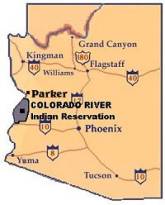 The
Imperial Valley is bright and very breezy today. Sand races in sheets
across the highway. Each time I travel across this section of the land,
I am struck by the timelessness and consistent truth of this enduring
gift to the people. Harsh, severe, dry, well yes but the clarity of the
lessons at the very heart of the cultures is to endure, endure, and endure.
In the same token this is one of the reasons we have come to the Yuman
language conference by the Colorado river.
The
Imperial Valley is bright and very breezy today. Sand races in sheets
across the highway. Each time I travel across this section of the land,
I am struck by the timelessness and consistent truth of this enduring
gift to the people. Harsh, severe, dry, well yes but the clarity of the
lessons at the very heart of the cultures is to endure, endure, and endure.
In the same token this is one of the reasons we have come to the Yuman
language conference by the Colorado river.
 There is a good group of local Kumeyaay and concerned students of the
Yuman language: Larry Banagas (Larry is on the left in the picture.) and
his wife Carol, Jane Dumas, Herman Osuna, Stan Rodriguez and his wife
Martha, Diane Tell His Name, Steve Newcomb, George Preieto, Ernest Moreno,
Kalim Smith and his family also Kenny Meza and Mariana Gomez.
There is a good group of local Kumeyaay and concerned students of the
Yuman language: Larry Banagas (Larry is on the left in the picture.) and
his wife Carol, Jane Dumas, Herman Osuna, Stan Rodriguez and his wife
Martha, Diane Tell His Name, Steve Newcomb, George Preieto, Ernest Moreno,
Kalim Smith and his family also Kenny Meza and Mariana Gomez.
We are here to experience: language, culture, song, stories. Many in traditional
format and some utilizing new technology to teach the old lessons. The
ride traveled is long but the experiences are rich and worth the effort.
The Colorado Indian Tribes (CRIT) reservation is composed of four tribes.
The Mohave have inhabited the area for thousands of years, while members
of the Chemehuevi, Hopi, and Navajo tribes relocated to the reservation
in the last hundred or more years.
There were many intriguing workshop choices. Commentary is from the ones I attended.
Title: Historic
Travels of the Yuman Tribes onto the American Continent
Category: Language Preservation\
Name/s: George Bryant
Tribe: Quechan
Description: An account of the migration of our people; a verbal
presentation in traditional language and its translation.
Quechan elder John Norton introduces George Bryant. Mr. Bryant states that this presentation is based from accounts that are from many different sources. Basically these are of the epic creation account of Kukwimat and his brother Askwimat. His first account is in Kwatsan. His description speaks of the wind swirling up high and away. He makes special emphases of, "Et Mach and Matta Kuerem." He then related the creation, account in English, "When the world was first made all was dark, it was covered with water. The two brothers were talking, ‘I’m going up to see what is up there. As Kuwimat came up he kept his eyes closed. When he went back down he said he saw nothing but the bright sun and water everywhere. This brother then put his finger in the water and with a song describing this action, he stirred up silt and mud. The other brother also came up but he opened his eyes and as a result was blinded." Mr. Bryant’s voice is rumbling and gravely. The impression is that these: voices, sounds and stories are from the ages and reflect the elders responsibility to voice these oral traditions in traditional environments according to custom and tradition.
Title: Traditional
Hand Game-Peon
Category: Traditional Arts
Presenter(s): Michael Miralez, Meyshia Ward, Bo Bullchild
Tribe: Torres Martinez Desert Cahuilla
Description: Basic instruction in playing traditional hand games
for the youth. They will be taught to call and play the game.
On the first day the Peon workshop presenters were still en-route. However, Xalychidom Piipaash Ron Carlos and Kelly Washington explain a stick die game. Like the game of peon (pawn) this game also has a Spanish term associated, Quince or fifteen. Ron said they had been over to San Xavier to sing Bird songs and came across this Quis game being played. He said that is the way the game is pronounced there. There is an entry fee and side bets are common as in other traditional gambling games. Basically it is a game of four staves, each which have different markings and different values. The combinations of the markings determine movement on the playing field.
The playing field and counters are arranged on a track or racecourse. How it is played is determined by regional consent. Always ask as to the local variations before the game! In the main the ‘horses’ markers run around and back on the track. The horses are going around the world from the starting position and the fire, which is simultaneously the same location. There are combinations that may cause the horse to be burned up or killed. Winner takes all with side bets.
 Thursday
evening traditional singing exchange begins with Ron Carlos (On the right
in the picture.) calling up singers to the microphone. Youth, women, singers
near and famous are in view of the assembled communities tonight. Each
group will sing five songs. This is a guarantee that we will hear many
varied and favorite songs. The first group is composed of local youth.The
singing continues from group to group. It is an overwhelming emotion to
view the spontaneous response of the women participants.
Thursday
evening traditional singing exchange begins with Ron Carlos (On the right
in the picture.) calling up singers to the microphone. Youth, women, singers
near and famous are in view of the assembled communities tonight. Each
group will sing five songs. This is a guarantee that we will hear many
varied and favorite songs. The first group is composed of local youth.The
singing continues from group to group. It is an overwhelming emotion to
view the spontaneous response of the women participants.
All these beautiful:
capes, scarves, shawls and ribboned dresses. Moving colors flashing in
rhythm to the movement of the song. In the steps of the dance: here the
ladies hop, there they turn, constantly smiling and greeting each other
dancer. Elders, children, more and more come out to participate in the
dance.
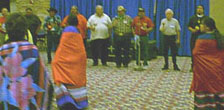 Stan
Rodriguez, Kumeyaay, sings some Nimii/Wildcat songs with good support.
Stan
Rodriguez, Kumeyaay, sings some Nimii/Wildcat songs with good support.
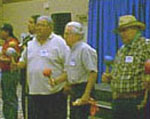 Dale
Phillips, Cocopah Vice-Chairperson is fourth or fifth in the sequence.
Ben Nance and myself have been attending his Cocopah philosophy class
for the past two years. In the second half of the class we have been singing
Bird songs and practicing the sequence of songs in their proper order.
We were looking forward to an occasion to sing with him in public and
he was generous to encourage our participation.
Dale
Phillips, Cocopah Vice-Chairperson is fourth or fifth in the sequence.
Ben Nance and myself have been attending his Cocopah philosophy class
for the past two years. In the second half of the class we have been singing
Bird songs and practicing the sequence of songs in their proper order.
We were looking forward to an occasion to sing with him in public and
he was generous to encourage our participation.
Ron Carlos announced to all singers that wished to step up and join any
group in support of the singing. Singers rotate and recombine in constantly
changing rows. There are an amazing amount of women dancers participating!
This is one of those emotional moments that seem to fill your chest. It
feels real good to be an Indian person.
A group also sings Lasha. This is yet another variation in the Yuman song
style.
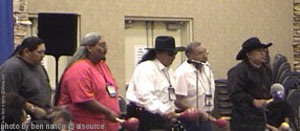 |
 |
Young boys from Torres
Martinez sing those Cahuilla Bird songs. This style is always entertaing
to watch. The center group of male dancer/singers posture and dip in a
seductive manner. Each group of singers is encouraged by good support.

Keith Mahone, Hualipi recording artist also has his turn at the microphone.
The entire presentation is a fitting tribute and finale to the first day
of General sessions, socializing and workshops.
Title: Kiliwa
Indian Language and Traditional Arts
Category:
Language Preservation
Names:
Leonor Farlow
Tribe: Kiliwa
Description:
Leonora Farlow will speak about the efforts to preserve the language in
which only a handful of speakers still use. Farlow will also bring examples
of some of the traditional items that she makes. (dolls, fiber skirts,
necklaces) explaining the significance with in the culture. The presentation
will be done in Kiliwa, Spanish and English.
Title: Writing, Stabilizing, Documenting the Indian Languages with
Authentic Sound.
Category:
Technology- Language Preservation- 3 hrs.
Presenter(s):
Ted Vaughn
Tribe:
Yavapai
Description:
The presentation has been developed to write the Indian Languages and
record the words to link with the Phonetic or Established spelling.
The intent will be
as follows:
a. Teach the
participant the format that will be used (a template of the format will
be supplied)
b. Creating
a written vocabulary in the tribal language phonetically, if there is
no established writing system.
c. Recording
the particular tribal language.
Hyper-linking the written tribal word with the recorded tribal word.
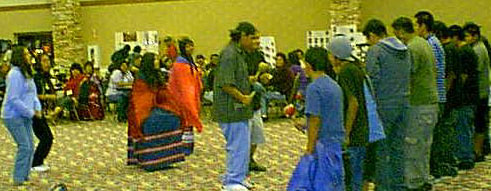 |
Short reflections on trip back to San Diego, CA.
I was born in Arizona and it makes my heart ache to realize the magnificent majesty of the evening sunset. I just feel the severity if the landscape multiplies the evident glory. At the same time I realize that the distance and time away from Arizona is a major influence of my itinerant poignant view.
To belong to a place with a certainty of time without time is a humble and magnificent feeling. Songs run with me continually on the journey back. Songs heard, songs remembered, songs unheard and yet to be sung. The movement and vibrations of the trip on that long strait drive on Arizona 95 seem to loosen up bubbles and pieces of songs: each compelling and competing to be sung. Arizona 95 is two lanes, fast, with dips, road noise and traffic. A fine setting for singing many songs!
Finally, I extend the greatest consideration to the organizers and director of the conference, Gary Owens Jr. Also, our sincere condolences to the family for the loss of their close relative. Even under these trying circumstances so many people opened their heart and made every effort to realize our major responsibility is to the Pai Yuman Language. The language is what carries us forward in our custom and tradition and continues to define: who we were, who we are and who we will become. Mehan.
